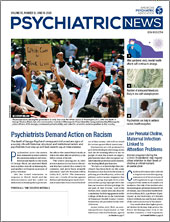The APA Assembly approved a request from the DSM Steering Committee to add diagnostic codes and definitions for suicidal behavior and nonsuicidal self-injury to Section II of the DSM-5-TR.
Section II is designated for “Other Conditions That May Be a Focus of Clinical Attention.” The new diagnoses must be approved by the Board of Trustees before they are incorporated into the manual. DSM-5-TR is scheduled for release next spring, in conjunction with APA’s 2021 Annual Meeting.
Approval of the DSM Steering Committee request was one of dozens of issues addressed by the Assembly in a virtual meeting in April, prior to the start of the virtual APA Spring Highlights Meeting. Because of the COVID-19 pandemic, all of APA’s in-person meetings have been suspended for the rest of 2020 and will be held instead on virtual platforms.
At the Assembly meeting, members also elected new officers (see box).
Paul Appelbaum, M.D., chair of the DSM Steering Committee, explained that the new diagnoses on suicidal behavior and nonsuicidal self-injury do not represent “mental disorders,” such as are listed in Section I of DSM-5.
“They are instead behaviors that may be associated with a variety of mental disorders for which the presence of an explicit category and means of coding can be helpful both for research—such as tracking prevalence and correlates—and clinical care, for instance, by decreasing the likelihood that the potential for suicide or nonsuicidal self-harm will be overlooked as treatment continues.”
He said the chapter titled “Other Conditions That May Be a Focus of Clinical Attention” is the designated section for diagnoses that are not mental disorders in themselves, but for which it is useful to have a systematic way of coding.
The committee’s report to the Assembly stated: “Even when clinicians are primed to identify and record a history of suicidal behavior or ideation, its documentation is unreliable. The risk of not recording suicidal behavior would be reduced if it were a codable entity in DSM-5-TR, as such conditions are typically conserved during hand-offs and in discharge summaries.”
Appelbaum noted that although Assembly and Board approval are usually reserved only for changes to mental disorders listed in Section I, explicit approval was sought in this case “because of the potential significance of these categories.”
The Assembly also approved an action paper calling for continued and increased advocacy with other physician groups to oppose an executive order that overrides state scope-of-practice laws. The October 2019 executive order from the Trump administration requires procedures and/or general medical and mental health services be reimbursed equally by Medicaid and Medicare regardless of the credentials of the health care professional.
Last year, APA joined more than 20 other medical groups in signing onto a letter from the AMA opposing the order. In January APA CEO and Medical Director Saul Levin, M.D., M.P.A., wrote to the Centers for Medicare and Medicaid Services expressing concern about the executive order’s threat to physician supervision of allied health professionals.
“Advanced practice registered nurses and physician assistants are an essential part of the health care workforce,” Levin wrote. “[T]hey may be the first and last person to interact with a patient during an episode of care and are well equipped to play a much-needed role in the health care team. However, for complex medical conditions, physician oversight is often critical to the development and implementation of a plan of care. We would ask the administration to consider policy alternatives that prioritize and reward team-based care.”
Additionally, the Assembly approved 17 proposed position statements and two revised position statements. If they are approved by the Board, all of the statements will be posted in the policy finder database on APA’s website. ■
The AMA letter about the Medicare executive order is posted
here.
The APA letter on physician supervision of allied health professionals is posted
here.
Official APA position statements are posted
here.
The Action Paper Tracking System can be accessed
here.
